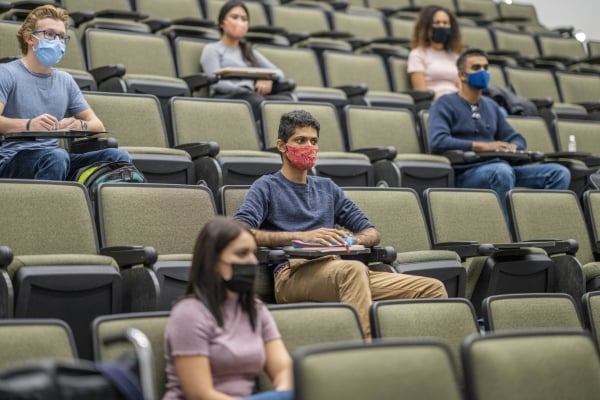Many students said their grades during the pandemic were worse than they expected.
Emerging federal data offers a nuanced portrait of the challenges the COVID-19 pandemic created for the generation of students who entered higher education at the onset of the public health crisis.
For one, about 73 percent of students who started college for the first time during the 2019–20 school year experienced pandemic-related stress and anxiety the following school year, according to data the National Center for Education Statistics (NCES) released this morning.
But the data shows that those anxieties affected certain groups of students more than others.
For instance, nearly 90 percent of students who identified as genderqueer or gender nonconforming reported pandemic-induced stress, compared to 80 percent of female students and 64 percent of men. And the source of that anxiety differed by demographic group as well; female, genderqueer, Black, Native and older students were among those who reported higher rates of job loss and difficulty paying for housing or food than their peers who did not share those identities.
“We already knew that almost everyone struggled in some way, but we now have a stronger sense of outcomes for students who experienced disruptions or changes due to COVID-19 as a result of the longitudinal design of this study,” NCES commissioner Peggy Carr said in a news release.
The new data is part of the first look at the latest Beginning Postsecondary Students Longitudinal Study, which is spending six years following a cohort of roughly 37,330 students who enrolled in college in 2019–20.
David Richards, a study director at the NCES who oversaw the production of the report, said this iteration of the study—the NCES has conducted a similarly designed study every six to eight years since 1990—just happened to coincide with the start of the pandemic, which presented an opportunity to include questions about related disruptions in the student surveys administered during the 2020-21 academic year.
“It’s closer to ground zero in terms of when the pandemic struck, so the effects are likely to be more salient and easier to measure,” Richards said. “The further out we go from that year, the less salient the effects of COVID-19 will be.”
The NCES, the statistical center in the U.S. Department of Education’s Institute of Education Sciences, uses a mix of student surveys and institutional and federal data to track a cohort of first-time students over six-year periods. The goal is to gather nationally representative data about persistence and completion rates, transition to employment, student demographic characteristics, and changes over time in students’ goals, marital status, income and debt, among other indicators.
The new report also provides data about completion and retention as of 2022, or the halfway mark for the longitudinal study, which will conclude at the end of this academic year.
While only a small percentage of students in the pandemic-era cohort had attained a credential by June 2022, 65 percent were still enrolled in college during the 2021–22 academic year. And although 23 percent had stopped out by that point, they did so at a much lower rate than their peers in the previous cohort, 44 percent of whom had stopped out by the three-year mark.
That suggests “higher education did incredibly well given incredible challenges,” said Nathan D. Grawe, an economics professor and enrollment expert at Carleton College.
But completion rates were down: Only 7 percent of the current cohort had completed an associate degree at the three-year mark, compared to 11 percent of the 2011 cohort.
“Given the disruptions documented in the present study, that outcome is hardly a surprise,” Grawe said in an email. “Moreover, the present NCES study is only a 3-year snapshot—we’ll learn much more about the ultimate effects on attainment in future waves.”
Grades Worse Than Expected
One new potential attainment factor researchers included in this cohort was online learning, which the majority of students were forced to participate in as a result of the pandemic.
Of the first-time students who took most or all of their courses online during the 2020–21 school year, 72 percent who earned some type of credential by 2022 said they engaged mostly in online learning; 31 percent of those students reported receiving grades lower than expected because of the pandemic.
By comparison, 80 percent of students who had not yet earned a credential by 2022 (but were still enrolled three years after starting college) said they took most or all of their classes online during the 2020–21 academic year; 41 percent of those students said they received grades lower than expected.
The mismatch between students’ expected performance and their actual grades may be attributable to the rise of online learning precipitated by the pandemic, said Ed Venit, managing director at EAB, an education consulting firm. “As a result, the actual way we deliver education is evolving and expectations may be out of alignment with the current state of the classroom,” he said.
But he added that there’s also a deeper, longer-term issue at play: Learning loss resulting from pandemic disruptions likely left students less prepared for college-level coursework than their professors expected.
As such, the learning loss reflected in the NCES report is just “the beginning of the curve,” he said, noting that students who were in high school during the pandemic will carry their deficits to college in the decade to come. “This is the front end of a trend that’s likely going to intensify.”

